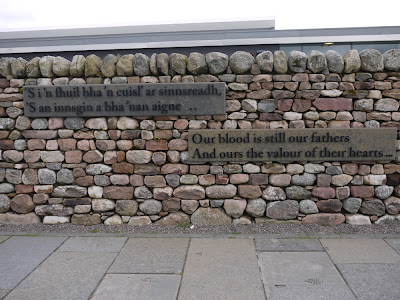This is the wall at the entrance to the Culloden Moor exhibition centre in Inverness in the Scottish Highlands. Before I entered the centre I knew I was Scottish, I knew that there had been battles in history that were both won and lost, but after going through this exhibition and walking along the battlefield, I felt about where I came from a lot differently.
If you aren’t really into history, then let me outline for you what I learned about the battle of Culloden; Most people go into the exhibition thinking this was a battle between the Scottish and the English for possession of the throne, but people don’t see it for what it actually was – a British civil war.
The battle was between two political groups; The Jacobites lead by ‘Bonnie’ Prince Charlie, made up of Scottish highlanders along with some Irish and French influence, and the British Hanoverian Government army lead by Prince William of Cumberland. Most people are lead to believe that the British Government was an English army, but I learned that there were some Scots among them, meaning that within the battle some men were fighting against their own brothers, cousins and other family members.
On the 16th of April 1746 the Jacobites, tired and hungry but also driven and full of angst gathered at their lines (marked with a blue flag, which are still there today) ready to fight, and the British Government army at there’s (marked with a red flag). The Jacobites finally charged at the Government army and as they got closer opened fire , to which the Government fired back with their canons and the battle began. Eventually the Jacobites were forced to retreat their forces and return to their lines but despite that, the Duke of Cumberland gave the order to his army to have ‘no mercy’ . Nobody was spared. In the space of forty five minutes in battle, around 2000 Jacobite soldiers were killed and 50 on the opposing side with around 300 men on the government army left severely wounded; the battle was over, and the Jacobite uprising had fallen.
The exhibition centre takes you on a series of events leading up to the battle, so you can understand more about it, eventually leading you to a room which shows four separate screens (one on each wall). On each wall appears both sides and before you know it you are in a 360 degree view of what the battle was like, and if that doesn’t speed up your heart rate I don’t know what will. The exhibition also shows you an interactive plan of the battle, paintings and drawings made illustrating the events, and some of the weapons and bullets found on the battlefield itself.
Outside the exhibition centre you will see this wall which has bricks sticking out. This isn’t just interesting architecture, each of this outward bricks is for each of the Jacobites who died here in the horrific battle of Culloden, at the very end of the wall there is a gap and then a further 50 bricks for each of the Government army soldiers who also died on the battlefield.
I found the exhibition centre overall a very interesting visit. The exhibition itself is fantastic and educational, but as soon as you step on to the battlefield there is a really eerie feeling, it’s the kind of feeling you get when you go to places like this, knowing how many people died in a battle that is very significant in British history.
Below are some landscapes from Culloden which relate with the rest of my project;
A copy of the Declaration of Arbroath, signed in 1320 at Arbroath Abbey asserting Scotland's right to be an independent country - why the Jacobites fought AND something my dad made me put on my wall after our trip to Culloden.
The stone says this is where the 50 British Soldiers were buried but historians have found that there is no trace of them actually being there at all.
The Landscape above shows not even half of Culloden Moor Battlefield.
A memorial for all the Jacobite soldiers who died in battle on the day.
A British line flag still blowing in the wind today.











No comments:
Post a Comment